Related Research Articles
The IRT Lexington Avenue Line is one of the lines of the A Division of the New York City Subway, stretching from Lower Manhattan north to 125th Street in East Harlem. The line is served by the 4, 5, 6, and <6> trains.
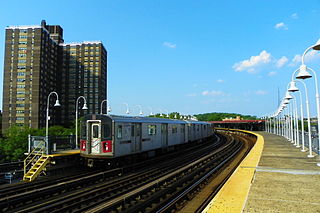
The White Plains Road Line is a rapid transit line of the A Division of the New York City Subway serving the central Bronx. It is mostly elevated and served both subway and elevated trains until 1952. The original part of the line, the part opened as part of the first subway was called the West Farms Division, and the extension north to 241st Street as part of the Dual Contracts was called the White Plains Road Line. Eventually, however, the two parts came to be known as the White Plains Road Line.

The Franklin Avenue/Botanic Garden station is a New York City Subway station complex shared by the IRT Eastern Parkway Line and the BMT Franklin Avenue Line. Located at the intersection of Franklin Avenue and Eastern Parkway in Brooklyn, the complex consists of two distinct stations, connected by a passageway within fare control, and is named for its proximity to the Brooklyn Botanic Garden. The Eastern Parkway Line station is served by the 2 and 4 trains at all times, the 3 train at all times except late nights, and the 5 train on weekdays only. The Franklin Avenue Line station is served by Franklin Avenue Shuttle (S) at all times.
The 129th Street station was a transfer station on the IRT Third Avenue Line in Manhattan, New York City, shared by elevated trains of both the Third Avenue Line and IRT Second Avenue Line. The next stop to the north was 133rd Street for the main line and Willis Avenue for the Willis Avenue spur, both of which were across a swing bridge above the Harlem River in the Bronx. The next stop to the south was 125th Street−Third Avenue for Third Avenue Line trains and 125th Street−Second Avenue for Second Avenue Line trains.
The 116th Street station was a local station on the demolished IRT Third Avenue Line in Manhattan, New York City. The outer tracks had two side platforms for local trains, and was built first. The center track was built as part of the Dual Contracts for express trains. This station closed on May 12, 1955, with the ending of all service on the Third Avenue El south of 149th Street.
The 106th Street station was an express station on the demolished IRT Third Avenue Line in Manhattan, New York City. The station was opened on December 30, 1878, and had two levels. The lower level had two tracks and two side platforms and served local trains. The upper level had one track and two side platforms over the local tracks on the lower level and served express trains. It was built as part of the Dual Contracts. The express run from this stop to 42nd Street was the longest express segment out of all New York City elevated lines, bypassing eight local stations. This station closed on May 12, 1955, with the ending of all service on the Third Avenue El south of 149th Street.
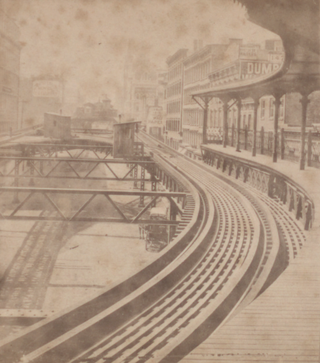
The 42nd Street station was an elevated express station on the demolished IRT Third Avenue Line in Manhattan, New York City. It had two levels with the lower level having three tracks. The main line tracks were served by two side platforms. A side platform connected to the southbound platform was used for shuttle service to Grand Central. The upper level was built as part of the Dual Contracts, and had one track and two side platforms over the two local tracks.
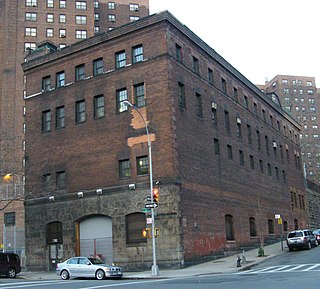
The 99th Street station was a local station on the demolished IRT Third Avenue Line in Manhattan, New York City. The station was originally built by the Manhattan Railway Company on December 30, 1878, and later had two levels. The lower level serving local trains was built first, and had two tracks and two side platforms. The upper level, built as part of the Dual Contracts had one track that bypassed the station and served express trains. This station closed on May 12, 1955, with the ending of all service on the Third Avenue El south of 149th Street. South of the station were connecting tracks to the 98th Street Yard. The station was also located next to Substation 7 an old IRT substation designed not only in order to electrify the Third Avenue Line, but the Second and Ninth Avenue elevated lines as well. Later it even served as a power source for the IRT Lexington Avenue Line from 1918 until the 1970s. The substation is still owned by the MTA and has been listed on the National Register of Historic Places since February 9, 2006.
The 89th Street station was a local station on the demolished IRT Third Avenue Line in Manhattan, New York City. It was originally built on December 9, 1878. The outer tracks were served by local trains and two side platforms. The center track was built as part of the Dual Contracts, it bypassed the station and served express trains. 89th Street station was the terminus of the IRT Third Avenue Line until it was expanded to 129th Street on December 30, 1878. This station closed on May 12, 1955, with the ending of all service on the Third Avenue El south of 149th Street. North of the station were connecting tracks to the 98th Street Yard.

The 76th Street station was a local station on the demolished IRT Third Avenue Line in Manhattan, New York City. It was originally built on December 9, 1878. The outer tracks served local trains and it had two side platforms. The center track was built as part of the Dual Contracts and was served by express trains. This station closed on May 12, 1955, with the ending of all service on the Third Avenue El south of 149th Street.

The 59th Street station was a local station on the demolished IRT Third Avenue Line in Manhattan, New York City. It was built on September 16, 1878. The local trains used two tracks and two side platforms. The center track was built as part of the Dual Contracts and was used for express trains. Due to its location along the east side of the headquarters for Bloomingdale's, the station was also known as "Bloomingdale's Station." The station was also the first rapid transit stop in the city to have an escalator, installed in September 1901. This station closed on May 12, 1955, with the ending of all service on the Third Avenue El south of 149th Street.

The 53rd Street station was a local station on the demolished IRT Third Avenue Line in Manhattan, New York City. It was served by local trains and had two tracks and two side platforms. The center track was built as part of the Dual Contracts and was used for express trains. This station closed on May 12, 1955, with the ending of all service on the Third Avenue El south of 149th Street.
The 47th Street station was a local station on the demolished IRT Third Avenue Line in Manhattan, New York City. It was served by local trains by two tracks and two side platforms. The center track was built as part of the Dual Contracts and was used for express trains. This station closed on May 12, 1955, with the ending of all service on the Third Avenue El south of 149th Street.
The 34th Street station was a local station on the demolished IRT Third Avenue Line in Manhattan, New York City. The station was served by Third Avenue local trains and a shuttle to the 34th Street Ferry. Third Ave service originally had two tracks and two side platforms. During the Dual Contracts, a center express track was built. The shuttle to the ferry was served by two tracks and an island platform attached to the northbound side platform. North of the station the westbound track of the shuttle merged with the main line.
The 28th Street station was a local station on the demolished IRT Third Avenue Line in Manhattan, New York City. It had three tracks and two side platforms. The express track was built as part of the Dual Contracts and bypassed the station. This station closed on May 12, 1955, with the ending of all service on the Third Avenue El south of 149th Street.
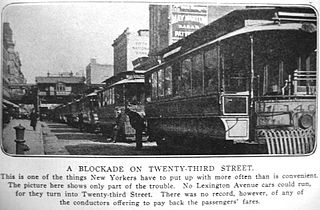
The 23rd Street station was an express station on the demolished IRT Third Avenue Line in Manhattan, New York City. It had two levels. The lower level was served by local trains and had two tracks and two side platforms. It was built first. The upper level was built as part of the Dual Contracts and had one track with two side platforms and served express trains. This station closed on May 12, 1955, with the ending of all service on the Third Avenue El south of 149th Street.
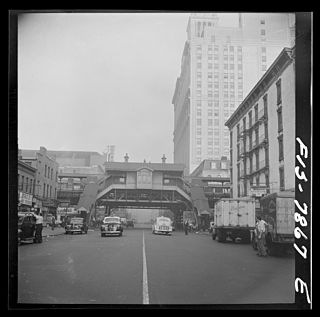
The 14th Street station was a local station on the demolished IRT Third Avenue Line in Manhattan, New York City. It had two levels. The lower level was served by local trains and had two tracks and two side platforms. It was built first. The upper level was built as part of the Dual Contracts and had one track that bypassed the station and served express trains. In 1924, the Brooklyn–Manhattan Transit Corporation built the 14th Street-Eastern District Line Subway below the station, which included the Third Avenue subway station. Although this station was located above the Third Avenue BMT subway station on what is today known as the BMT Canarsie Line, the two stations were never connected. This station closed on May 12, 1955, with the ending of all service on the Third Avenue El south of 149th Street.

The Ninth Street station was an express station on the demolished IRT Third Avenue Line in Manhattan, New York City. It opened on August 26, 1878 and had two levels. The lower level was served by local trains and had two tracks and two side platforms. It was built first. The upper level was built as part of the Dual Contracts and had one track with two side platforms over the lower level local tracks which served express trains. This station closed on May 12, 1955, with the ending of all service on the Third Avenue El south of 149th Street.
The 86th Street station was an express station on the demolished IRT Second Avenue Line in Manhattan, New York City. It had two levels. The lower level had two tracks and two side platforms, and was served by local trains. The upper level was built as a part of the Dual Contracts and had one track and two side platforms for express trains. The next stop to the north was 92nd Street for local trains and 125th Street for express trains. The next stop to the south was 80th Street for local trains and 57th Street for express trains. The station closed on June 11, 1940. The site is now served by the 86th Street station of the Second Avenue Subway.
The 66th Street station was an express station on the demolished IRT Ninth Avenue Line in Manhattan, New York City. It had two levels. The lower level was built first and had two tracks and two side platforms. The upper level was built as part of the Dual Contracts and had one track and two side platforms over the lower level local tracks. The station closed on June 11, 1940. The next southbound local stop was 59th Street. The next southbound express stop was 34th Street for Ninth Avenue trains, and 50th Street for IRT Sixth Avenue Line express trains. The next northbound local stop was 72nd Street. The next northbound express stop was 116th Street. The express run from this stop to 116th Street was the longest express segment out of all New York City elevated lines, bypassing seven local stations.
References
- ↑ "Third Avenue El Makes Last Trip". The Kingston Daily Freeman. May 13, 1955. p. 10. Retrieved May 30, 2020– via Newspapers.com.

- ↑ "Rapid Transit to Harlem" (PDF). The New York Times Company. 31 December 1878. p. 8. Retrieved 21 February 2009.
- ↑ NYCTA Notice of Third Avenue Rail Closure for May 12, 1955
- "3rd Avenue El". nycsubway.org. Archived from the original on 27 January 2009. Retrieved 2009-01-25.
- "Third Avenue Local". Station Reporter. Archived from the original on 2010-06-09. Retrieved 2009-01-25.